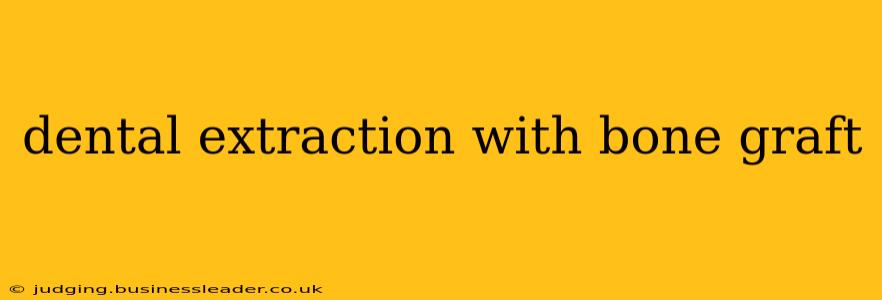Dental extractions, while sometimes necessary, can leave behind gaps in your jawbone. This bone loss can lead to further dental problems down the line, making a bone graft a crucial consideration for many patients. This comprehensive guide explores dental extraction with bone grafting, addressing common questions and concerns.
What is a Bone Graft After a Tooth Extraction?
A bone graft is a surgical procedure where bone tissue is transplanted into the area of your jaw where a tooth has been extracted. This added bone material stimulates the growth of new bone, preventing further bone loss and providing a solid foundation for future dental procedures like dental implants. The transplanted bone can come from various sources, including your own body (autograft), a donor (allograft), or synthetic materials (alloplastic). Your dentist will determine the best type of bone graft based on your individual needs and the specifics of your case.
Why is a Bone Graft Necessary After a Tooth Extraction?
The jawbone relies on the stimulation of tooth roots to maintain its density. Once a tooth is extracted, the bone in that area begins to resorb (dissolve) over time. This bone loss can lead to several issues, including:
- Difficulty placing dental implants: Implants require a sufficient amount of healthy bone to anchor securely. Bone loss makes implant placement challenging or impossible.
- Facial sagging: Bone loss can alter the shape of your jaw, leading to a sunken or collapsed appearance in the affected area.
- Shifting teeth: The remaining teeth can shift into the empty space left by the extraction, affecting your bite and potentially causing misalignment.
What are the Different Types of Bone Grafts?
There are several types of bone grafts used in dental procedures. The choice depends on the amount of bone loss, the location of the extraction site, and your overall health.
- Autograft: Bone is harvested from another site in your body, usually your chin or hip. This is considered the "gold standard" because it integrates well with the existing bone.
- Allograft: Bone is taken from a donor. This bone is processed and treated to minimize the risk of disease transmission.
- Xenograft: Bone is derived from an animal source, usually a cow.
- Alloplast: This is a synthetic bone substitute.
What Happens During a Dental Extraction with Bone Graft?
The procedure typically involves two stages:
- Extraction: The affected tooth is carefully removed. The extraction site is thoroughly cleaned and prepared for the bone graft.
- Graft placement: The bone graft material is carefully placed into the extraction site. Stitches are used to close the area, and a protective membrane may be placed over the graft to promote healing.
The entire procedure is usually performed under local anesthesia, so you will be comfortable during the process.
How Long Does Recovery Take After a Dental Extraction with Bone Graft?
Recovery time varies depending on the type and extent of the bone graft. You can expect some swelling, bruising, and discomfort for several days. Your dentist will provide detailed post-operative instructions, including pain management and oral hygiene guidelines. Full healing can take several months, and it's crucial to follow your dentist's instructions carefully to ensure successful integration of the bone graft.
What are the Risks and Complications of Dental Extraction with Bone Graft?
While generally safe, there are potential risks associated with any surgical procedure, including:
- Infection: The risk of infection is minimized through strict sterilization protocols.
- Bleeding: Minor bleeding is common, but excessive bleeding is rare.
- Nerve damage: In rare cases, nerve damage can occur.
- Graft rejection: This is more common with allografts.
- Delayed healing: Healing time can be longer than expected in some cases.
How Much Does a Dental Extraction with Bone Graft Cost?
The cost of a dental extraction with bone grafting varies significantly depending on several factors, including the type of bone graft, the complexity of the procedure, your location, and your dentist's fees. It is always best to consult your dentist for an accurate estimate.
Does Insurance Cover Dental Extraction with Bone Graft?
Many dental insurance plans offer some coverage for dental extractions and bone grafts, but the extent of coverage depends on your specific plan. It's crucial to contact your insurance provider to determine your coverage before proceeding with the procedure.
This guide provides a comprehensive overview of dental extraction with bone grafting. However, it's essential to consult with a qualified dentist to determine the best course of action for your individual circumstances. They can assess your specific needs, answer your questions, and guide you through the process. Remember that this information is for educational purposes only and should not be considered medical advice.
